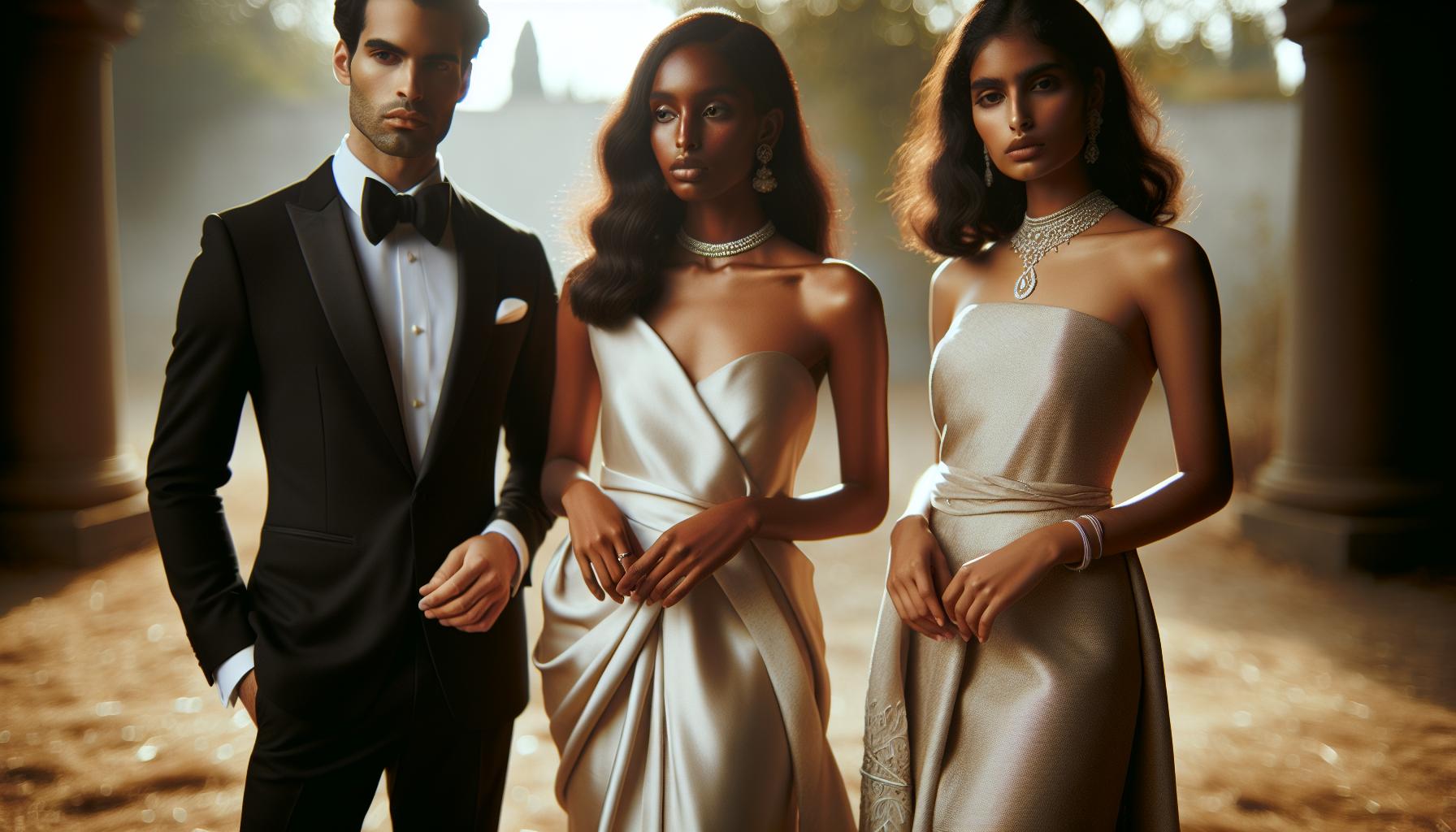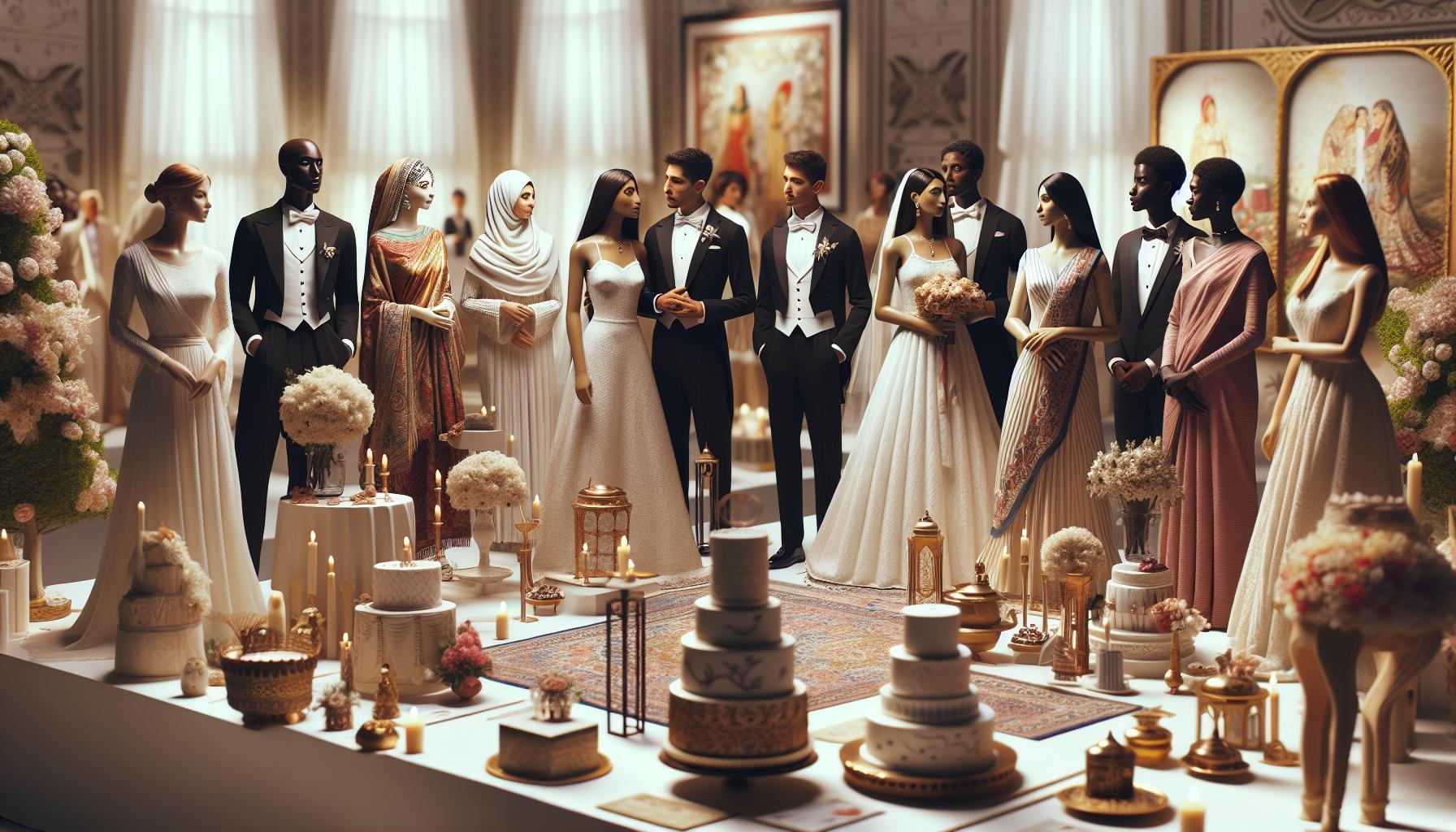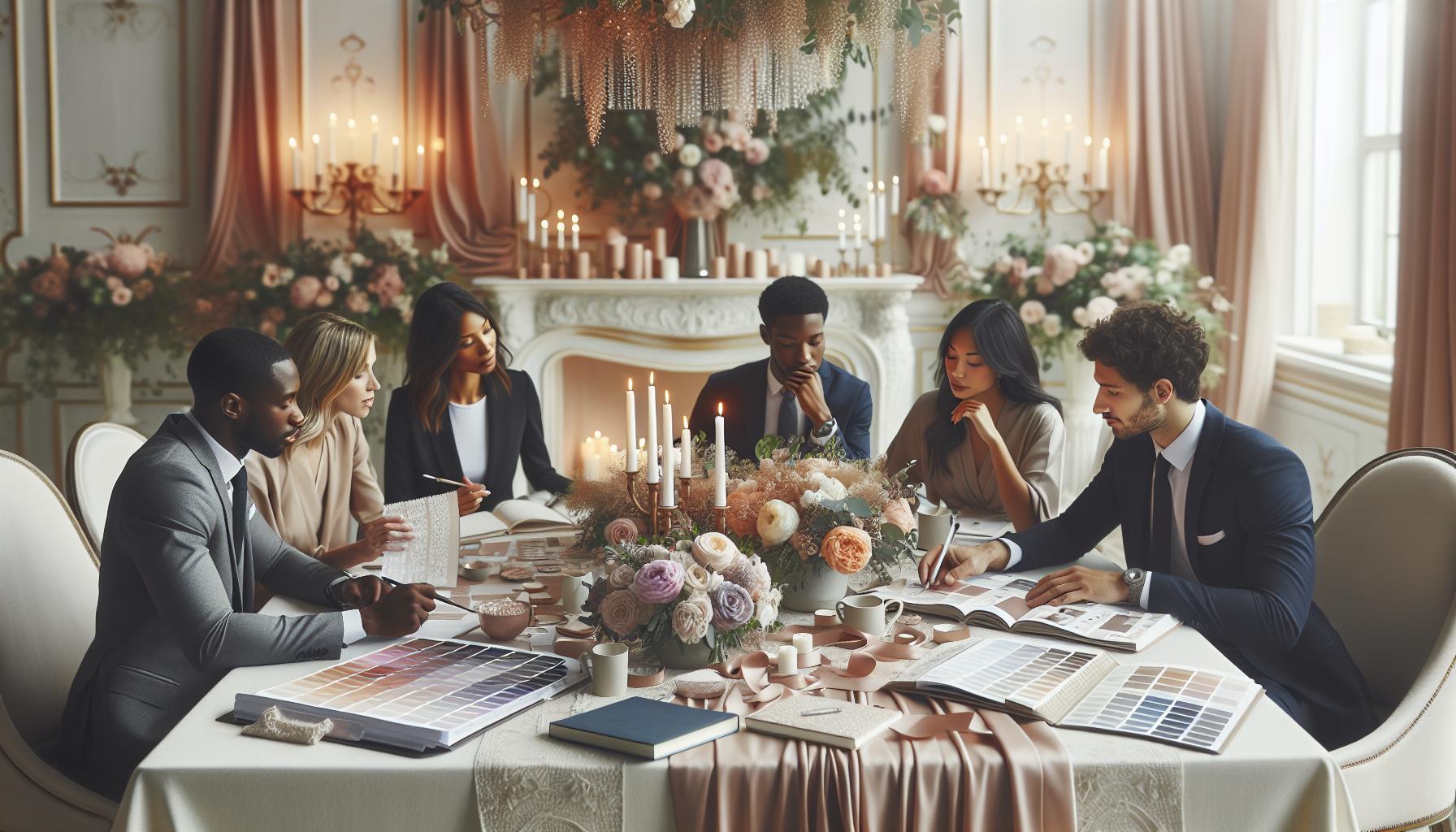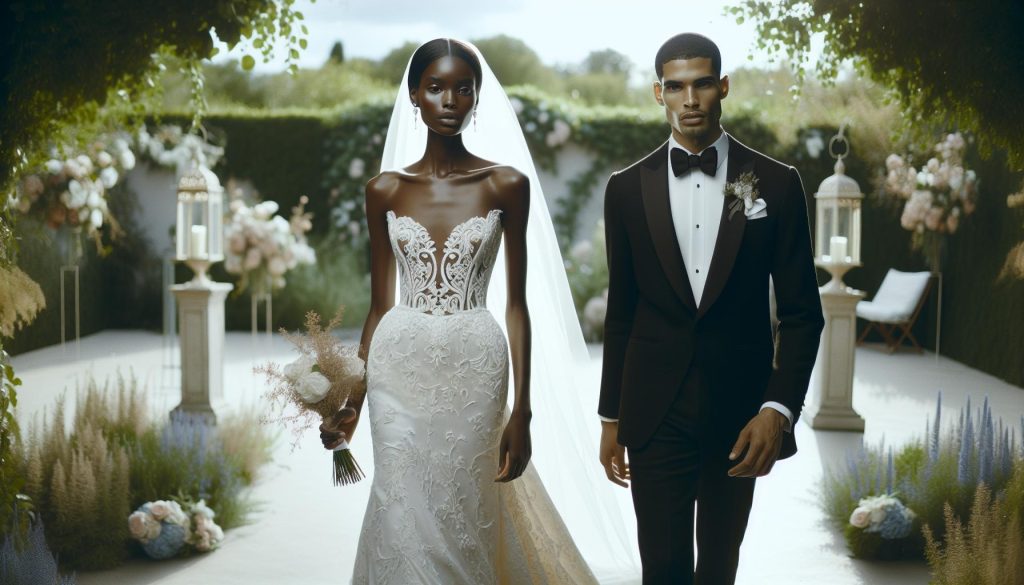Weddings are significant milestones that beautifully blend love, culture, and personal expression. When it comes to formal weddings, understanding what “formal” truly means is essential for creating the day of your dreams. Do you envision a glamorous affair with elegant attire, sophisticated décor, and an air of exclusivity? Or are you seeking to strike a balance between tradition and your unique style?
This guide will navigate you through the intricacies of formal wedding planning, covering everything from attire to etiquette, ensuring you feel confident in your decisions. Whether you’re wondering about dress codes, reception themes, or how to incorporate personal touches within formal settings, our comprehensive insights will illuminate your path. Join us as we explore the enchanting world of formal weddings, making your special day both memorable and reflective of your unique love story. Let’s dive in!
What Does “Formal” Mean in Wedding Attire?

Understanding what “formal” means in wedding attire can significantly influence your planning as you navigate this momentous occasion. Generally, a formal dress code exudes elegance and sophistication, calling for attire that adheres to the highest standards of style and decorum. Couples planning a formal wedding typically envision a classic aesthetic characterized by upscale materials and designs that reflect tradition while embracing personal flair.
When considering formal attire, remember that it often includes specific garment types such as evening gowns for brides and formal suits or tuxedos for grooms. Brides may opt for dresses made of luxurious fabrics like silk or satin, featuring intricate lace, embroidery, or beading for added sophistication. Accessories complementing the ensemble, such as elegant gloves, elaborate veils, and statement jewelry, can enhance the overall look, bringing a touch of personal style to the formality.
For the groom, formal options typically encompass well-tailored suits or tuxedos, which may include elements like cummerbunds or bow ties that add an air of refinement. Footwear should also be carefully selected-shoes made of polished leather or stylish loafers can tie the outfit together. It’s essential to ensure that the attire fits well and aligns with both the wedding theme and the couple’s personal aesthetic.
By clearly defining the formal attire expectations with your wedding invitations and communicating them to your guests, you create a cohesive vision for your celebration. Ultimately, understanding the essence of formal attire allows couples to weave their unique love story into the intricacies of an elegant wedding day, ensuring that every detail, from dress to venue, resonates with grace and style.
Understanding Different Formal Wedding Styles

Exploring various formal wedding styles can make the planning process both exciting and a bit daunting, but it’s essential for crafting the perfect celebration. A formal wedding typically embraces a timeless elegance, and understanding these styles will help couples align every aspect of their wedding from decor to attire with their overall vision. While there are common themes among formal weddings, they also vary widely based on cultural traditions, personal preferences, and seasonal considerations.
To begin, there are generally three primary styles of formal weddings: traditional, modern, and destination.
Traditional Formal Weddings
Traditional formal weddings often reflect long-standing customs and can feature classic venues such as churches, ballrooms, or historical estates. Brides in this scenario usually don flowing white gowns with intricate lace detailing, while grooms don classic tuxedos or formal suits. The ceremony may include a religious service, followed by a formal reception with a sit-down dinner, traditional dances, and speeches.
Modern Formal Weddings
In contrast, modern formal weddings may break away from traditional expectations while still maintaining an air of sophistication. These weddings can take place in more unconventional venues like art galleries, rooftop gardens, or industrial spaces. Brides might opt for sleek, contemporary designs with clean lines and bold accents, while grooms can choose to mix and match modern suits with fun accessories like patterned ties or pocket squares to showcase their personalities. The reception can also embrace creative catering and entertainment, moving beyond the usual format of a formal sit-down dinner.
Destination Formal Weddings
Destination weddings often incorporate both formal style and a sense of adventure, allowing couples to celebrate in unique locales – from sandy beaches to majestic mountains. The attire may vary based on location, with brides choosing lighter fabrics suited for warmth while maintaining elegance, such as chiffon or lightweight silk gowns. Grooms can opt for lighter-colored suits or even linen options that allow for comfort without sacrificing style. Invitations might suggest attire adaptations based on the climate or cultural nuances of the destination, ensuring that guests are prepared for the celebration.
In addition to these styles, it’s essential to consider how elements such as color schemes, floral arrangements, and overall themes reflect the chosen style of formality. Effective communication through invitations can guide guests on attire expectations and establish a cohesive look for the entire event. By carefully considering which formal wedding style resonates most with their love story, couples can create a magical atmosphere to celebrate their union, making the planning process not only manageable but also joyfully memorable.
Essential Elements of Formal Wedding Invitations
Crafting formal wedding invitations is an art that blends elegance with practicality, serving as the first glimpse of your magical day. These invitations set the tone for your celebration, offering guests an insight into the atmosphere, style, and expectations surrounding the event. A well-designed invitation not only communicates essential details but also reflects personal style and the gravity of the occasion.
To begin with, include:
- Invitation Wording: The wording should be sophisticated and follow traditional etiquette. Use full names and titles, and if applicable, include the hosts’ names (often the parents of the bride and groom). For example, a standard opening might read: “Mr. and Mrs. John Smith request the honor of your presence at the marriage of their daughter Jane Marie to Mr. James Allen Brown.”
- Date and Time: Clearly state the date and time of the ceremony. It’s common to write out the month and time fully (e.g., “the seventeenth of June, two thousand twenty-five at four o’clock in the afternoon”). This adds a formal touch and enhances readability.
- Venue Details: Include the full name and address of the venue where the ceremony will take place. This helps guests find the location easily, especially for those who may be unfamiliar with the area.
- Dress Code: If you desire guests to adhere to a specific attire, make this clear on the invitation. Phrases like “black tie” or “formal attire requested” can guide your guests in selecting appropriate outfits.
- RSVP Information: Provide clear instructions on how guests should RSVP, whether through a website, phone number, or a prepaid RSVP card included with the invitation. This step is vital for planning purposes and ensures an organized guest list.
Focus on the design elements of your invitation, as well. Choosing high-quality paper and elegant typography can elevate the overall aesthetic. Opt for classic colors such as ivory, gold, or deep burgundy, which evoke a formal atmosphere. Consider embellishments such as foil stamping or embossing to add a luxurious touch.
In the realm of wedding planning, your invitations are more than just a way to convey information; they are a treasured keepsake that portrays the story of your love. The right design and wording can solidify the expectations of formality and create a sense of anticipation for what is sure to be a memorable celebration.
How to Choose Formal Wedding Colors and Themes

Choosing colors and themes for a formal wedding sets the stage for a sophisticated celebration. The palette you select will not only reflect your personal style but also enhance the overall atmosphere of your event, creating a romantic backdrop that resonates with elegance. Opt for colors that evoke a sense of timelessness and luxury, such as rich jewel tones, classic neutrals, or soft pastels. Pairing colors thoughtfully can transform each detail – from floral arrangements to table settings – into a cohesive visual narrative that captures the essence of your celebration.
Classic Color Combinations
To achieve a refined aesthetic, consider these classic combinations that evoke formality:
- Black and White: This timeless duo exudes sophistication and is perfect for evening ceremonies.
- Gold and Ivory: The warmth of gold against the softness of ivory creates an opulent yet understated vibe.
- Navy and Blush: Navy provides a rich contrast to the gentle allure of blush, making it ideal for a romantic setting.
- Emerald Green and Champagne: This pairing embodies elegance, with deep green suggesting lushness and champagne adding a touch of warmth.
When selecting your theme, think about how each color influences emotional responses and complements your venue. A formal wedding often gravitates toward themes inspired by classic elegance, such as vintage glamour, garden sophistication, or modern minimalism. Each theme can dictate the décor, style of invitations, and attire for the bridal party, so choose a cohesive theme that reflects both of your personalities and shared vision.
Incorporating Personal Touches
While it’s essential to adhere to formal aesthetics, finding ways to incorporate personal elements can make your wedding uniquely yours. For example, if you have a cultural tradition, consider integrating it through colors that hold significance within that context. Alternatively, you might want to include favorite colors or meaningful artifacts in subtle ways-such as in your bouquet or table centerpieces-that add character while remaining true to the formal tone.
Ultimately, the colors and theme you select should evoke joy and anticipation for your special day, making your celebration feel like a dream come true. Remember that planning your formal wedding doesn’t have to be overwhelming; embracing the process with creativity will lead to a memorable and enchanting experience.
Bridal Attire: Navigating the Formal Dress Code

Every bride dreams of walking down the aisle dressed in a way that reflects her unique style while adhering to the formal nature of a wedding celebration. Formal bridal attire typically exudes elegance and sophistication, making it crucial for brides to understand the nuances of what’s traditionally accepted within this dress code. This journey begins with selecting a wedding gown that embodies the essence of formality-often characterized by luxurious fabrics, intricate details, and a silhouette that enhances the natural beauty of the bride.
When navigating the formal dress code, consider traditional gown styles such as ball gowns, A-line dresses, or mermaid silhouettes, which convey a sense of grandeur. Fabrics like silk, satin, lace, and tulle not only elevate the formality of your attire but also contribute to a regal and romantic aesthetic. Embellishments such as beading, embroidery, or delicate appliqués can add a touch of glamour, while long trains and veils are classic elements that enhance the overall bridal look.
In addition to the gown, accessories play a pivotal role in completing the formal wedding ensemble. Opt for elegant shoes, perhaps adorned with crystal detailing, and select jewelry that complements the gown without overwhelming it-think timeless pearl earrings or a delicate necklace. Additionally, consider how your bridal hairstyle aligns with the formality of your look; an updo often suits formal events beautifully, allowing for a polished appearance.
Choosing the right bridal attire is not just about adhering to established norms; it’s an opportunity to express personal style. If you have cultural traditions that influence your attire, such as wearing a particular color or style, don’t hesitate to incorporate those elements. Ultimately, the key is to blend personal flair with the classic aesthetics of formal wear, culminating in a bridal look that not only captivates but also feels authentically you.
Groom’s Attire: Suits, Tuxedos, and Style Tips
Selecting the ideal attire for the groom on such a momentous day can be both exhilarating and a bit daunting. When it comes to formal wedding attire, the groom has a variety of options that can enhance his style while complementing the overall theme of the celebration. A classic choice, the tuxedo, is often seen as the epitome of formal wear. With its sharp lines and elegant finish, it embodies sophistication and sets the tone for a grand event. However, modern interpretations allow for a bit of creativity, whether it’s choosing a tailored suit with unique textures or incorporating personalized accessories that speak to the couple’s shared style.
Choosing the Right Attire
When deciding between a tuxedo and a suit, consider the formality of the wedding and the venue. A traditional black tuxedo is suitable for evening weddings and grand venues, while a well-fitted suit can work beautifully for daytime or less formal settings. When selecting colors, classic shades like black, navy, or charcoal are always safe bets. However, don’t shy away from lighter hues or even textured fabrics, such as linen or tweed, especially for spring or summer weddings. Incorporating a vest or cummerbund can also elevate the look, providing an additional layer of style.
- Tuxedo: A timeless choice with options for shawl or peak lapels.
- Suit: Versatile and available in varied colors, allowing personal expression.
- Accessories: Incorporate a unique tie or bow tie, pocket square, and cufflinks for a personalized touch.
Tailoring and Fit
Regardless of the choice, fit is crucial. An ill-fitting garment, no matter how stylish, can detract from the overall presentation. Investing in bespoke tailoring ensures a polished appearance that enhances the groom’s silhouette. Pay attention to the details: the trousers should break just right over the shoes, the shoulders should fit snugly without pulling, and the sleeves should hit at the wrist bone, allowing the shirt’s cuff to peek through. These small details can make a significant impact on the overall look.
In addition to the attire itself, coordinating with the bridal party in terms of colors and styles can create a harmonious aesthetic. Whether opting for matching outfits or subtle variations that allow for individuality, the groom’s attire should align with the bridal vision while still allowing him to shine. The heart of formal wedding attire lies in striking a balance between tradition and personal flair, ensuring that the groom feels confident and radiant as he embarks on this beautiful journey of love.
Formal Wedding Ceremony: Traditions and Etiquette
A formal wedding ceremony is a captivating blend of tradition, elegance, and romance that sets the stage for one of life’s most significant moments. Understanding the customs and etiquette associated with such a ceremony can help couples create a magnificent event that reflects their love and commitment while honoring the rituals of matrimony. From the choice of venue to the structure of the ceremony, every detail contributes to the formal ambiance that distinguishes this special occasion.
When planning a formal wedding ceremony, consider incorporating time-honored traditions like a grand entrance, meaningful readings, and symbolic elements such as the lighting of a unity candle or the exchange of rings. The processional order is also essential; typically, it begins with the officiant, followed by the groom and his party, and culminates with the stunning entrance of the bride. Including live musicians or a string quartet can enhance the grandeur, filling the air with melodies that set a romantic tone.
Strong attention to detail is vital, especially regarding etiquette. For instance, it’s customary for the groom and his party to wear formal attire, such as tuxedos, while the bridal party may opt for floor-length gowns. Communication is key-ensure that invitations clearly state the dress code to guide guests in dressing appropriately. If there are cultural or religious traditions you wish to incorporate, make this known to your officiant so they can integrate these elements seamlessly into the ceremony.
Another significant aspect of formal ceremonies is the serene environment. Selecting a venue that complements the formal aesthetic-whether it’s a grand ballroom, a historic church, or a beautiful garden-can enhance the overall atmosphere. Consider floral arrangements, elegant seating, and appropriate lighting to create a magical backdrop. By thoughtfully blending traditions, adhering to etiquette, and curating a stunning setting, couples can craft a formal wedding ceremony that is both memorable and deeply personal.
Selecting Formal Venue Settings for Your Wedding
Selecting the right venue for a formal wedding is one of the most crucial steps in planning, as it sets the tone for the entire celebration. The venue not only serves as the backdrop for beautiful memories but also reflects the couple’s style and the event’s formality. Carefully choosing a space that embodies elegance and sophistication enhances the overall experience, ensuring that every moment resonates with a sense of grandeur and joy.
When considering venue options, think about locations that naturally lend themselves to formal aesthetics. Options such as historic mansions, luxurious ballrooms, or beautifully manicured gardens provide an ideal canvas for a formal affair. These settings can be adorned with elegant chandeliers, intricate table settings, and stunning floral arrangements that elevate the ambiance. It’s essential to consider the capacity of the venue as well, ensuring it can comfortably accommodate your guest list while maintaining an intimate feel that encourages connection and celebration.
Accessibility is equally important in selecting a venue. Ensure that it is conveniently located for your guests, considering travel options and accommodations nearby. If the ceremony and reception will take place at different locations, arrange transportation to streamline the experience for everyone involved. Clear communication about the location and any parking or accessibility details will help ensure that your guests feel welcomed and accommodated from the moment they arrive.
Lastly, don’t forget about the practicalities of the venue when planning. Consider the available amenities, such as sound systems for music and speeches, kitchen facilities for catering, and indoor/outdoor options that provide versatility in case of weather changes. By focusing on the specifics while keeping the overall vision of a formal wedding in mind, couples can create a seamless experience that aligns beautifully with their desires while honoring the traditions that make their day so special.
Coordination Tips for a Formal Wedding Day
Planning a formal wedding is an exciting venture that calls for meticulous coordination and attention to detail. To ensure that your big day unfolds seamlessly, effective organization is key. Begin by creating a comprehensive timeline that incorporates all elements of the day, from the ceremony to the reception. This timeline will serve as a roadmap, helping you and your vendors stay aligned and on schedule.
Establishing Communication
Clear communication is essential for a successful wedding day. Designate a point person, such as a trusted friend or family member, to coordinate with vendors and manage any last-minute issues that may arise. This allows the couple to focus on enjoying their special moments instead of getting bogged down in logistical details. Keep a checklist of contact numbers for all vendors and share it with your point person. This ensures that everyone knows who to reach out to if assistance is needed.
Detailing the Ceremony and Reception Flow
Outline the sequence of events for both the ceremony and reception. For a formal wedding, it’s particularly important that each aspect of the day adheres to the planned schedule. Consider creating a detailed document that includes timings for the processional, speeches, dances, and cake cutting. Share this document with your officiant, wedding planner, and other key participants to ensure that everyone is on the same page.
Vendor Coordination and Arrangements
When working with vendors, set specific times for their arrival and set-up to avoid any last-minute chaos. Whether it’s florists, caterers, or photographers, ensure that they know their roles and timelines. Conduct a rehearsal prior to the wedding day to familiarize everyone with the flow of events and address any potential hiccups before the actual ceremony. This rehearsal can significantly ease nerves and ensure confidence in execution.
- Rehearsal Dinner: This is a great opportunity to go over the ceremony flow with the wedding party and family members.
- Day-Of Planner: If budget allows, hiring a day-of coordinator can take a substantial weight off the couple’s shoulders.
- Emergency Kit: Prepare an emergency kit that includes items like safety pins, a sewing kit, and extra makeup for touch-ups-ideal for addressing any unforeseen issues.
With careful planning and coordination, your formal wedding will not only reflect your personal style but also create magical memories. Remember, the essence of your special day lies in celebrating love with your dearest family and friends, so prioritize the joy and connection that will shine through every detail.
How to Incorporate Formality into Wedding Decor
Creating an atmosphere of elegance and sophistication at your wedding is crucial for capturing the essence of formality. Every element, from floral arrangements to table settings, plays a role in setting the tone for this special day. To successfully incorporate formality into your wedding decor, it’s essential to focus on a cohesive design that reflects your style while adhering to traditional elements that evoke a sense of grandeur.
Start by choosing a color palette that resonates with formal aesthetics. Rich, deep tones such as navy, burgundy, or emerald green paired with metallics like gold or silver can create an opulent feel. Consider using luxurious fabrics like satin and silk for table linens and drapery to elevate your decor significantly. Opt for intricate patterns or textures to ensure each element feels thoughtfully curated.
Centerpieces and Floral Arrangements
The centerpiece is a focal point at each table, so choose arrangements that are not only beautiful but also reflect the formal nature of your event. Tall, structured floral arrangements made from elegant blooms like peonies, orchids, or roses can add height and sophistication. Incorporate crystals or candles into your designs for added glamour. Ensure that the floral colors complement your overall theme, and use lush greenery to add depth.
Lighting and Ambiance
Lighting can transform a space, creating an inviting yet refined atmosphere. Soft, warm lighting can be achieved with a combination of chandeliers, uplighting, and candles. Opt for candelabras or elegant candle holders to enhance the formal vibe, allowing flickering flames to cast a romantic glow across the room. Additionally, consider the use of fairy lights or strings of pearls to add a whimsical touch while maintaining sophistication.
Dinnerware and Table Settings
The details of your table settings can make a substantial impact. Use fine china, crystal glassware, and polished flatware to elevate the dining experience. Layer your table with exquisite table runners and chargers, pushing the formal envelope even further. Personalized place cards and elegant menus can also add a special touch that highlights the formality of your event and offers a hint of intimacy.
In summary, a formal wedding can be a beautiful blend of elegance and personal style. By thoughtfully selecting your decor, from color schemes to table settings, you can create an enchanting environment that reflects your love story while adhering to traditional wedding expectations. This attention to detail will not only impress your guests but also create lasting memories for you and your loved ones as you celebrate your commitment in style.
Unique Touches: Personalizing Your Formal Wedding
Your wedding day is a once-in-a-lifetime event, a time to express your love uniquely and authentically. Personalizing your formal wedding can transform the traditional into something distinctly yours, imbuing the ceremony and celebration with meaningful touches that reflect your journey together. From the décor to the attire, every detail offers an opportunity to infuse your personality and shared memories into the day.
One way to personalize your formal wedding is through customized elements that tell your story. Consider incorporating photographs into the decor, such as a display of your favorite moments together or a timeline of your relationship. This could be a beautiful gallery wall at the reception with snapshots from your adventures, or a charming photo table that showcases both of your families’ histories. Additionally, personal touches can extend to your invitations and programs. Use unique fonts or colors that represent you as a couple, and don’t shy away from including a meaningful quote or personal message that speaks to your love.
Another distinctive aspect of your wedding can be found in the floral arrangements andCenterpieces. While traditional florals are often used, think outside the box by incorporating flowers or plants that have special significance to you, such as those from your first date or a location that holds sentimental value. You could also include meaningful symbols or mementos, like family heirlooms or items that reflect shared hobbies, into your centerpieces. This will not only elevate the visual impact of your decor but also spark conversations among your guests, connecting them to your shared story.
When it comes to attire, adding personal touches can elevate the formality while showcasing individuality. For the bridal party, consider unique accessories that honor your journey, like customized cufflinks for groomsmen or a family brooch pinned to the bridal bouquet. One of the most touching ways to personalize your wedding look is to include something old, something new, something borrowed, and something blue-each item representing a facet of your personal history or the journey leading to this moment.
Ultimately, personalizing your formal wedding isn’t just about the tangible details-it’s about crafting an experience that resonates with you and your loved ones. By weaving in elements that celebrate your relationship, you create a beautiful tapestry of memories that will be cherished long after the last dance, leaving an indelible mark on the hearts of all who attend.
Budgeting for a Formal Wedding Celebration
Planning a formal wedding celebration involves thoughtful budgeting that reflects the elegance and significance of the occasion while ensuring every detail aligns with your vision. It’s essential to start with a clear understanding of your overall budget and to allocate funds to various elements of your wedding in a manner that honors both tradition and personal style. By breaking down your spending across different categories, you can create a comprehensive plan that ensures no aspect of your grand celebration is overlooked.
Begin by determining your total budget and dividing it into key components of the wedding. Consider essential categories such as venue, catering, attire, flowers, photography, and entertainment. Within each category, you can set sub-budgets based on average costs and your specific preferences. For example:
- Venue: 30% of your budget for a sophisticated setting that reflects your theme.
- Catering: 25% for an exquisite dining experience, including hors d’oeuvres and drinks.
- Attire: 15% for elegant bridal and groom’s outfits, along with accessories for the bridal party.
- Flowers and Decor: 10% for stunning arrangements that complement your theme.
- Photography/Videography: 10% to capture every precious moment beautifully.
- Entertainment: 5% for a band or DJ to keep the atmosphere lively.
Another critical step in budgeting is to anticipate additional costs that may arise. These can include items like transportation for guests, wedding favors, or unexpected vendor fees. It’s wise to reserve about 10-15% of your budget for these contingencies. Additionally, opting for a flexible approach can help, as reaching out for quotes from various vendors can often lead to discovering hidden gems that may fit well within your budget.
Lastly, maintain an open dialogue with your partners and family regarding financial contributions and priorities. This synergy will help create a celebration that mirrors both your dreams and your shared finances, ensuring that you enjoy the planning process as much as the auspicious day itself. Remember, the essence of a wedding is not solely in lavish spending but in the love and commitment shared between you and your partner, and thoughtful budgeting can make that possible without compromising your vision.
Q&A
Q: What are the key components of formal wedding attire?
A: Formal wedding attire typically includes elegant clothing such as tuxedos for grooms and long gowns for brides. Accessories like bow ties, cufflinks, and formal shoes enhance the sophistication. For more tips on attire, check the Bridal Attire section of our guide.
Q: How do you choose a formal wedding theme?
A: Selecting a formal wedding theme involves considering elegant color schemes, luxurious decor, and sophisticated venue options. Popular themes include classic black and white or garden elegance. Explore our How to Choose Formal Wedding Colors and Themes section for more ideas.
Q: What should wedding guests wear to a formal wedding?
A: Guests should opt for cocktail dresses, evening gowns, or tuxedos. Avoid casual attire like jeans or sundresses. Refer to our What Does “Formal” Mean in Wedding Attire? section for detailed guidelines.
Q: What makes a wedding ceremony formal?
A: A formal wedding ceremony often features traditional elements such as a specified dress code, formal invitations, and ceremonial traditions such as vows and toasts. For etiquette and traditions, check our Formal Wedding Ceremony: Traditions and Etiquette section.
Q: How can decorations enhance the formality of a wedding?
A: Decorations such as elegant floral arrangements, fine table linens, and sophisticated lighting can greatly enhance a wedding’s formal ambiance. For incorporation ideas, see our How to Incorporate Formality into Wedding Decor section.
Q: What are some mistakes to avoid when planning a formal wedding?
A: Common mistakes include neglecting the dress code, overspending on certain elements, or choosing an inappropriate venue. For more guidance, refer to our Budgeting for a Formal Wedding Celebration section.
Q: How do you personalize a formal wedding?
A: Personalizing a formal wedding can include custom vows, unique decor elements, and personalized favors. Check our Unique Touches: Personalizing Your Formal Wedding section for creative ideas.
Q: When is it appropriate to have a formal wedding?
A: Formal weddings are ideal for evening ceremonies, grand venues, or when couples wish to set a sophisticated tone. Consider your style and preferences when deciding. More insights are available in our main article.
In Summary
Understanding “What Does Formal Mean for a Wedding” is just the beginning of your exciting journey. With a clearer vision of formal attire and etiquette, you’re now equipped to make informed decisions that reflect your style and values. Ready to dive deeper? Explore our articles on wedding invitation etiquette and popular ceremony traditions to enrich your planning experience.
Don’t forget to subscribe to our newsletter for the latest wedding trends and tips, ensuring you’re always one step ahead. If you have questions or need personalized advice, consider scheduling a consultation with our experts. Your dream wedding is within reach, and every detail matters. Share your thoughts in the comments below or connect with fellow couples who are on this beautiful journey alongside you. Let’s celebrate love together!











